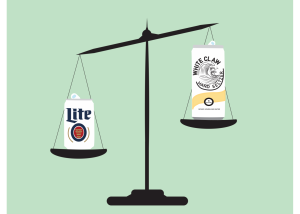Body Dysmorphia Afflicts Young Men, Too
Men are unrecognized among those suffering from body dysmorphia despite also struggling
COURTESY OF MARK DUNAI
Mark Dunai continues to works out to achieve fitness goals while staying mindful of his health.
February 19, 2022
Content Warning: This article discusses suicidal thoughts and body dysmorphia.
Feeling insecure about a certain aspect of your body is something that everyone can relate to. As you get ready in the morning, you may notice a pimple on your face and try to cover it up. Maybe after a meal, you feel bloated and try to conceal your belly with different poses. Throughout the day, though, you forget about your insecurity. You simply walk outside with your pimples and bloated stomach and carry on with your day.
For some people, these self-conscious thoughts stay in the forefront of their minds all day — as if there’s a spotlight shining solely on their insecurity. The thoughts around their bodies are inconsolable and overwhelming. They feel as if they should be ashamed of their appearance. Sometimes these worries can be so all-consuming that they lead to suicidal thoughts.
This is a mental illness called body dysmorphic disorder (BDD) and is most commonly seen among people with eating disorders or disordered eating habits. While BDD begins during adolescence, eating disorders can become more prevalent later in life. According to the National Eating Disorders Association (NEDA), “Full-blown eating disorders typically begin between 18 and 21 years of age.”
While the causes of the disorder may be similar among individuals, each case is unique.
Some of these “imperfections” noticed by those with BDD feel real to them, regardless of whether others notice. The idea of these perceived flaws prevents those with the disease from living a normal life. BDD is similar to obsessive-compulsive disorder (OCD), in which obsessive thoughts hinder an individual’s daily actions and can lead them to seek isolation from social groups. Removal from social settings can sometimes lead to depression or decreased productivity.
According to Johns Hopkins Medicine, BDD is caused by biological factors, including a history of the disease in the family. Chemical imbalances and situational factors, like being bullied during adolescence, may also contribute to the development of BDD.
While the causes of the disorder may be similar among individuals, each case is unique. This is because societal norms influence the perception of illnesses like BDD.
“There are a lot of male action figures who are just very muscular … this is very unreasonable.”Mark Dunai, fitness social media content creator
Women are more well known to have eating disorders. Factors such as social media, films and celebrity idolization often make women more susceptible to having self-image issues. Men face similar problems as well, but these issues are oftentimes suppressed and unnoticed, even by medical professionals.
Mark Dunai, a fitness social media content creator, commented on the impact of social media on body image, specifically highlighting the toys that men are exposed to during adolescence.
“There are a lot of male action figures who are just very muscular … this is very unreasonable,” Dunai said. “It puts a little pressure on people thinking that this is the societal norm. Usually, you don’t see people walking around who look like Superman. I don’t think it’s terrible for people to look up to it — it’s just not realistic.”
Men with eating disorders don’t have the same body image concerns as women do.
While the idea of admiring superheroes and desiring muscles may seem harmless, the consequences can be dire.
Anorexia is the deadliest mental illness, and although men make up 25% of those suffering from the disease, they make up the majority of deaths. Physicians fail to recognize the illness because “clinical assessment tools emphasize a desire to lose weight as opposed to building muscle.”
This means that surveys and tests researchers use to identify eating disorders, such as the EDI-3, use language that favors female responses. Men with eating disorders don’t have the same body image concerns as women do, and the tests are often better at measuring factors more applicable to women than to men. While women are typically encouraged by society to be thin, men are encouraged to be muscular.
Men with muscle dysmorphia struggle to view themselves as physically adequate.
Athletes are especially susceptible to BDD. A study by Jennifer Carter, a psychologist at the Ohio State University Sports Medicine Center, found that about 1.1% of male athletes suffer from the illness, but research in the field is lacking. This is also tied to the prevalence of performance-enhancing drugs and substances, such as creatine.
NEDA describes a subtype of BDD known as muscle dysmorphia, which mostly affects male bodybuilders. According to NEDA, those with muscle dysmorphia “obsess about being adequately muscular. Compulsions include spending many hours in the gym, squandering excessive amounts of money on supplements, abnormal eating patterns, or use of steroids.”
Men with muscle dysmorphia struggle to view themselves as physically adequate. They tend to view their muscles as being too small and have convinced themselves that they are weak and frail. Because they view themselves as weak, bodybuilders will continue to push their bodies to new extremes, which can cause physical harm.
Dunai has his own method of keeping his body in check during phases when he plans on changing his fitness goals.
The difference between having normal health goals and having muscle dysmorphia is the obsessive thoughts and dangerous actions taken to achieve the “perfect body.”
Dunai ensures that he keeps his body in check by listening to its needs. Specifically, he tries to avoid excessive repetitions, or reps, at the gym.
“I do two to three sets, but every set is very intense,” Dunai said. “Four sets of 12 is a very common rep range. I try not to do that because I think that is too much for me.”
The constant physical abuse that men with BDD face is not only dangerous for their bodies but also their lives.
Dunai has his own method of keeping his body in check during phases when he plans on changing his fitness goals, like gaining muscle weight or losing fat.
“I do take pictures of myself; in early December, I got a camera, and I would just take pictures of how I looked at my peak weight,” Dunai said.
The constant physical abuse that men with BDD face is not only dangerous for their bodies but also their lives. Medical professionals often overlook men because the idea of being muscular and strong is idealized in society.
BDD impacts people from all walks of life, but the research on how the illness impacts men, available treatments for them and public awareness is insufficient.















